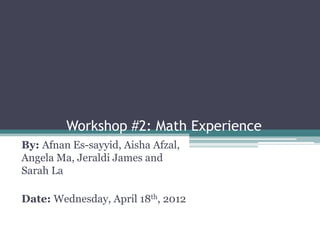
Ecep 131 workshop #2
- 1. Workshop #2: Math Experience By: Afnan Es-sayyid, Aisha Afzal, Angela Ma, Jeraldi James and Sarah La Date: Wednesday, April 18th, 2012
- 2. Curriculum Content Area • Physical Development • Cognitive Development • Social Development • Emotional Development • Language Development
- 3. Observational Notes • Afnan implemented a math counting experience for the children using Easter eggs that were already provided in the room. The children had a lot of Easter materials in the room and they were playing with it. They seemed to enjoy playing with the eggs and tell each other how many eggs they hand in their hand. So then, based on that cue Afnan encouraged the children to select a colour and count how many they had. After, her experience she asked the children to walk around the room and collect eggs while counting how many are in their basket. However, the older toddlers counted till eight. Then Jeraldi, implemented an abacus experience that she built from home based on the children is cues which was, one child was playing with a loop abacus and the other child was counting from a book. The children at her center used it by pushing the colors back and forth, up and down, and one child counted till three. Based on these two experiences we formed a type of abacus with an open end that allows the children to put foam of different shapes, sizes and colours through the rod instead of Easter eggs. We also, created one abacus that has Velcro and the children could place different coloured fruits on it. This encourages the children to count the objects while placing them through the rods.
- 4. Cue • Counting • Foam • Colours • Sizes • Eggs • Abacus
- 5. Big and Shape a small body Choo-choo mode Train Fingers Cloth pins songs with paper dolls Jar Make a Filling Collection POTENTIAL Count Hopscotch objects in EXPERIENCES the room Worms in Red Rover Apples Abacus Counting Waffles Lids & body parts Containers
- 6. Theory • “According to Piaget, the only way that they can learn social-arbitrary knowledge is from adults or more competent peers. Social-arbitrary knowledge consists of “arbitrary truths agreed upon by convention and rules agreed upon by coordination of points of view” (DeVries & Kohlberg, 1987, p.21). For example, in math the names of the numbers, signs, and shapes are examples of social- arbitrary knowledge. Teachers must support children’s learning as they use mathematical materials, helping them learn social-arbitrary knowledge” (Bullard, p. 187). This supports our math experience because there are numbers and shapes. • “An effective problem solver perseveres, focuses his attention, tests hypotheses, takes reasonable risks, remains flexible, tries alternatives, and exhibits self-regulation” (Copley, 2000, p. 31).” (Bullard, p. 188) this supports our experience because the children are keep themselves engaged putting foam through the rods or sticking fruits on the Velcro. • “It is easier for children to use materials that are less abstract for one-to-one correspondence. Therefore, teachers should first provide real objects, then cut outs, then pictures, and finally symbols and patterns (Charlesworth, 2005).” (Bullard, p. 192) This supports our experience because we’re providing the children with different type of materials to be used. • “Objects from songs, finger plays, or books that stress addition or subtraction. Teachers can introduce these activities during circle time and then place the props in the math area for children to use. For example, if telling a story involving a baker who added ingredients to create different dishes, you could add both the baker’s hat and the flannel board pieces to the math center (Zur & Gelman, 2004).” (Bullard, p. 194) • “The amount of teacher talk about math is significantly related to children’s achievement in math, with those teachers who use the math talk having children with the highest math skills at the end of the year (Klibanoff, Levine, Huttenlocher, Vasilyeva, & Hedges, 2006). “ (Bullard, p. 201) This activity helps develop the children’s math skills because they are putting the foam shapes onto the rod and counting it as well.
- 7. Set Up • Introduce experience prior to implementation • Lure children by: ▫ Laying out materials for the experience • Guidance Strategy: ▫ Ask open-ended questions ▫ Incorporate and promote motor skills ▫ Use manipulative materials
- 8. Materials • Abacus (base & rods) • Foam • Fruits (red & green apple, lemon, & orange)